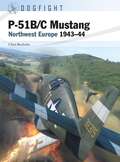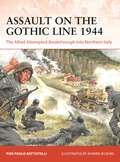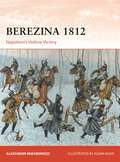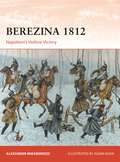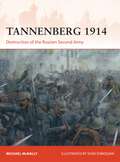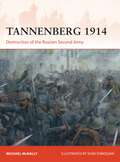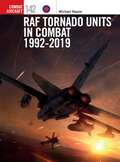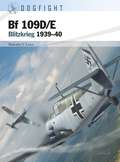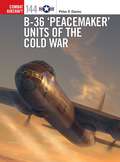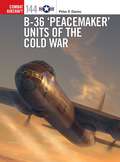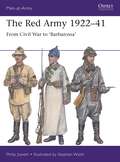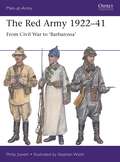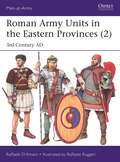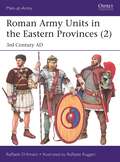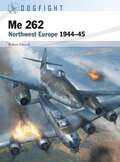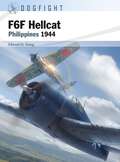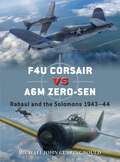- Table View
- List View
P-51B/C Mustang: Northwest Europe 1943–44 (Dogfight)
by Chris BucholtzThis new volume straps the reader into the cockpit of the P-51B/C as the Mustang-equipped fighter groups of the 'Mighty Eighth' Air Force attempt to defend massed heavy bomber formations from deadly Luftwaffe fighters charged with defending the Third Reich.Luftwaffe Reichsmarschall Hermann Göring admitted that the appearance of long-range Mustangs over Berlin spelled the end of the Jagdwaffe's ability to defeat American daylight bombing. But the Mustang was far more than an escort – it was a deadly hunter that could out-perform nearly every German fighter when it was introduced into combat. Entering combat in Europe in December 1943, P-51Bs and P-51Cs had advantages over German Bf 109s and Fw 190s in respect to the altitude they could reach, their rate of climb and top speed. Initially tapped for close bomber escort, Mustangs were quickly turned loose to range ahead of the bomber stream in order to challenge German fighters before they could assemble to engage the bombers en masse. Thanks to the Mustang's superior performance, USAAF pilots effectively blunted the Luftwaffe's tried and tested tactic for destroying B-17s and B-24s. Boldness and aggression in aerial combat meant that P-51B/C pilots inflicted a rapidly mounting toll on their German counterparts in the West during the early months of 1944, contributing mightily to Allied air superiority over northern France on D-Day. This volume, packed full of first-hand accounts, expertly recreates the combat conditions and flying realities for Mustang pilots (including headline aces such as Don Blakeslee and Don Gentile, as well as lesser known aviators). It is heavily illustrated with photographs, artwork and innovative and colourful 3D ribbon diagrams, which will provide a realistic overview of the most dynamic dogfights in aviation history.
P-51B/C Mustang: Northwest Europe 1943–44 (Dogfight)
by Chris BucholtzThis new volume straps the reader into the cockpit of the P-51B/C as the Mustang-equipped fighter groups of the 'Mighty Eighth' Air Force attempt to defend massed heavy bomber formations from deadly Luftwaffe fighters charged with defending the Third Reich.Luftwaffe Reichsmarschall Hermann Göring admitted that the appearance of long-range Mustangs over Berlin spelled the end of the Jagdwaffe's ability to defeat American daylight bombing. But the Mustang was far more than an escort – it was a deadly hunter that could out-perform nearly every German fighter when it was introduced into combat. Entering combat in Europe in December 1943, P-51Bs and P-51Cs had advantages over German Bf 109s and Fw 190s in respect to the altitude they could reach, their rate of climb and top speed. Initially tapped for close bomber escort, Mustangs were quickly turned loose to range ahead of the bomber stream in order to challenge German fighters before they could assemble to engage the bombers en masse. Thanks to the Mustang's superior performance, USAAF pilots effectively blunted the Luftwaffe's tried and tested tactic for destroying B-17s and B-24s. Boldness and aggression in aerial combat meant that P-51B/C pilots inflicted a rapidly mounting toll on their German counterparts in the West during the early months of 1944, contributing mightily to Allied air superiority over northern France on D-Day. This volume, packed full of first-hand accounts, expertly recreates the combat conditions and flying realities for Mustang pilots (including headline aces such as Don Blakeslee and Don Gentile, as well as lesser known aviators). It is heavily illustrated with photographs, artwork and innovative and colourful 3D ribbon diagrams, which will provide a realistic overview of the most dynamic dogfights in aviation history.
U.S. Civil War Battle by Battle
by Iain MacGregor'Just the thing for US Civil War buffs: snappily written, informative and entertaining. A cracking read.' Saul David, bestselling author and historianThis attractively packaged gift book offers a highly illustrated introduction to some of the U.S. Civil War's most famous and important battles, from the Battle of Fort Sumter in 1861 to the Battle of Appomatox Court House in 1865.The U.S. Civil War was the most cataclysmic military struggle of the late 19th century, and in four bloody years of fighting from 1861 to 1865 over 620,000 American soldiers and sailors lost their lives in more than 8,000 battles, engagements and skirmishes. U.S. Civil War Battle by Battle tells the story of 30 of the most significant of these battles. These include some of the most famous clashes, such as the battles of Gettysburg and Fredericksburg, which resonate through American military history, but also the less well known, such as the battles of Brandy Station and Cedar Creek. This highly illustrated introduction, packed full of colour artwork, covers every theatre of the war and details infantry, cavalry, artillery and seaborne units from both the Union and the Confederate forces to give a true sense of the scale of the War between the States.
U.S. Civil War Battle by Battle
by Iain MacGregor'Just the thing for US Civil War buffs: snappily written, informative and entertaining. A cracking read.' Saul David, bestselling author and historianThis attractively packaged gift book offers a highly illustrated introduction to some of the U.S. Civil War's most famous and important battles, from the Battle of Fort Sumter in 1861 to the Battle of Appomatox Court House in 1865.The U.S. Civil War was the most cataclysmic military struggle of the late 19th century, and in four bloody years of fighting from 1861 to 1865 over 620,000 American soldiers and sailors lost their lives in more than 8,000 battles, engagements and skirmishes. U.S. Civil War Battle by Battle tells the story of 30 of the most significant of these battles. These include some of the most famous clashes, such as the battles of Gettysburg and Fredericksburg, which resonate through American military history, but also the less well known, such as the battles of Brandy Station and Cedar Creek. This highly illustrated introduction, packed full of colour artwork, covers every theatre of the war and details infantry, cavalry, artillery and seaborne units from both the Union and the Confederate forces to give a true sense of the scale of the War between the States.
Assault on the Gothic Line 1944: The Allied Attempted Breakthrough into Northern Italy (Campaign)
by Pier Paolo BattistelliEnjoy a detailed examination of Operation Olive as US, British, Commonwealth and Allied forces seek to smash through the last German defensive line in Italy.The Italian theatre of operations post-summer 1944 was often (and incorrectly) surmised at the time as a quiet sector of World War II, populated with troops who were relieved not to find themselves fighting in North-West Europe. Yet the true nature of the hard fighting that took place here was soon revealed when the Allies began their assault on the Axis Gothic Line defences, known as Operation Olive. In this book, Italian military historian Pier Paolo Battistelli documents the dual Allied offensive spearheaded by American and British units to smash through what was supposed to be the final Axis defensive line in Italy before the Alps. The overall strategic aims of both the Axis and Allied leaders are explored, together with the organization of the forces committed.The expertly researched maps and 3D diagrams guide the reader through the progress of the phased battles in challenging terrain. Photographs and specially commissioned artworks show the soldiers that fought on both sides, including American, Canadian, Indian, Brazilian, Polish, New Zealander, British, German and Italian troops, as well as the materiel they employed. The result is an essential illustrated guide to a fascinating and complex late-war campaign.
Assault on the Gothic Line 1944: The Allied Attempted Breakthrough into Northern Italy (Campaign #387)
by Pier Paolo BattistelliEnjoy a detailed examination of Operation Olive as US, British, Commonwealth and Allied forces seek to smash through the last German defensive line in Italy.The Italian theatre of operations post-summer 1944 was often (and incorrectly) surmised at the time as a quiet sector of World War II, populated with troops who were relieved not to find themselves fighting in North-West Europe. Yet the true nature of the hard fighting that took place here was soon revealed when the Allies began their assault on the Axis Gothic Line defences, known as Operation Olive. In this book, Italian military historian Pier Paolo Battistelli documents the dual Allied offensive spearheaded by American and British units to smash through what was supposed to be the final Axis defensive line in Italy before the Alps. The overall strategic aims of both the Axis and Allied leaders are explored, together with the organization of the forces committed.The expertly researched maps and 3D diagrams guide the reader through the progress of the phased battles in challenging terrain. Photographs and specially commissioned artworks show the soldiers that fought on both sides, including American, Canadian, Indian, Brazilian, Polish, New Zealander, British, German and Italian troops, as well as the materiel they employed. The result is an essential illustrated guide to a fascinating and complex late-war campaign.
Berezina 1812: Napoleon’s Hollow Victory (Campaign)
by Professor Alexander MikaberidzeA superbly illustrated narrative of how Napoleon skilfully extracted his Grande Armee from the clutches of the pursuing Russian armies.Much has been written about the Battle of the Berezina and the 1812 Russian campaign in general, during which the cold winter devastated the Grande Armée. Historians often praise Napoleon for his actions at the Berezina and attribute his success to a brilliant strategic mind, laying a trap that deceived the Russians and resulted in a remarkable feat in the history of warfare. Drawing on contemporary sources (letters, diaries, memoirs), and featuring an extensive order of battle, this book recreates in hourly detail one of the great escapes in military history, a story often told with embellishments that require a more critical examination. Although the core of Napoleon's army escaped, tens of thousands were killed in the battle, trampled in the rush for the bridge, drowned in the icy waters of the Berezina, or captured. Written by an acknowledged expert on the period, and using a broad range of sources from all sides, this title brings to life in stunning visual detail, using maps, battlescene artworks and period illustrations, the events of late November 1812, as Napoleon's retreating, desperate Grand Armée extricated itself from the clutches of the Russian armies under Kutuzov, Wittgenstein and Chichagov in an epic feat of heroism and masterful tactics.
Berezina 1812: Napoleon’s Hollow Victory (Campaign)
by Alexander MikaberidzeA superbly illustrated narrative of how Napoleon skilfully extracted his Grande Armee from the clutches of the pursuing Russian armies.Much has been written about the Battle of the Berezina and the 1812 Russian campaign in general, during which the cold winter devastated the Grande Armée. Historians often praise Napoleon for his actions at the Berezina and attribute his success to a brilliant strategic mind, laying a trap that deceived the Russians and resulted in a remarkable feat in the history of warfare. Drawing on contemporary sources (letters, diaries, memoirs), and featuring an extensive order of battle, this book recreates in hourly detail one of the great escapes in military history, a story often told with embellishments that require a more critical examination. Although the core of Napoleon's army escaped, tens of thousands were killed in the battle, trampled in the rush for the bridge, drowned in the icy waters of the Berezina, or captured. Written by an acknowledged expert on the period, and using a broad range of sources from all sides, this title brings to life in stunning visual detail, using maps, battlescene artworks and period illustrations, the events of late November 1812, as Napoleon's retreating, desperate Grand Armée extricated itself from the clutches of the Russian armies under Kutuzov, Wittgenstein and Chichagov in an epic feat of heroism and masterful tactics.
Tannenberg 1914: Destruction of the Russian Second Army (Campaign)
by Michael McNallyExplore the Eastern Front battle that resulted in one of the greatest defeats of World War I, in which an entire Russian army was annihilated by German arms.Tannenberg is a major battle that deserves a fully illustrated treatment all of its own, and for the first time this book brings the epic Eastern Front clash to life in visual detail. No other book on this topic walks you through the action like this one, using detailed maps to provide unit locations and movements and help explain key command decisions, while period photographs and colour battlescenes put soldiering back at the core of the events by revealing the military material culture of the opposing sides. Michael McNally guides you through the initial border engagements and the battles of Gumbinnen and Stallupönen, before moving on to explore the massive, often confused running battle of Tannenberg in easy to follow and concise detail. This work helps you understand how the Germans managed to maul Samsonov's Second Army and all but destroyed the Russians as a fighting force. The Russian war plan of using overwhelming numbers to gain a quick victory before conducting further operations would soon lie in pieces on the ground. It also assesses the contribution modern technology – such as railways, aerial reconnaissance, radio and telegraphy – made to the emphatic German victory.
Tannenberg 1914: Destruction of the Russian Second Army (Campaign)
by Michael McNallyExplore the Eastern Front battle that resulted in one of the greatest defeats of World War I, in which an entire Russian army was annihilated by German arms.Tannenberg is a major battle that deserves a fully illustrated treatment all of its own, and for the first time this book brings the epic Eastern Front clash to life in visual detail. No other book on this topic walks you through the action like this one, using detailed maps to provide unit locations and movements and help explain key command decisions, while period photographs and colour battlescenes put soldiering back at the core of the events by revealing the military material culture of the opposing sides. Michael McNally guides you through the initial border engagements and the battles of Gumbinnen and Stallupönen, before moving on to explore the massive, often confused running battle of Tannenberg in easy to follow and concise detail. This work helps you understand how the Germans managed to maul Samsonov's Second Army and all but destroyed the Russians as a fighting force. The Russian war plan of using overwhelming numbers to gain a quick victory before conducting further operations would soon lie in pieces on the ground. It also assesses the contribution modern technology – such as railways, aerial reconnaissance, radio and telegraphy – made to the emphatic German victory.
RAF Tornado Units in Combat 1992-2019 (Combat Aircraft #142)
by Michael NapierAfter the Gulf War of 1990, No Fly Zones (NFZ) were established over northern and southern Iraq and the Tornado GR 1 force stepped up to operations over the southern NFZ. The Tornado GR 4 took responsibility for RAF combat air operations in Afghanistan from the Harrier force in 2009, and in 2011 was involved in missions against the Gaddafi regime in Libya. The unique multirole capabilities of the aircraft enabled it to support ground operations with the Raptor reconnaissance pod, Brimstone missiles and Paveway IV laser-guided bombs until withdrawal in 2014. The Tornado GR 4 was also used for operations over Iraq and Syria against the ISIL terrorist organisation. Intensive air operations were flown between 2014 and 2019, when the Tornado GR 4 was finally withdrawn from RAF Service.This volume, written by former RAF pilot Michael Napier, provides detailed first-hand accounts of the missions undertaken by the Tornado crews during the most recent conflicts over the Middle East and the Balkans.
RAF Tornado Units in Combat 1992-2019 (Combat Aircraft)
by Michael NapierAfter the Gulf War of 1990, No Fly Zones (NFZ) were established over northern and southern Iraq and the Tornado GR 1 force stepped up to operations over the southern NFZ. The Tornado GR 4 took responsibility for RAF combat air operations in Afghanistan from the Harrier force in 2009, and in 2011 was involved in missions against the Gaddafi regime in Libya. The unique multirole capabilities of the aircraft enabled it to support ground operations with the Raptor reconnaissance pod, Brimstone missiles and Paveway IV laser-guided bombs until withdrawal in 2014. The Tornado GR 4 was also used for operations over Iraq and Syria against the ISIL terrorist organisation. Intensive air operations were flown between 2014 and 2019, when the Tornado GR 4 was finally withdrawn from RAF Service.This volume, written by former RAF pilot Michael Napier, provides detailed first-hand accounts of the missions undertaken by the Tornado crews during the most recent conflicts over the Middle East and the Balkans.
Bf 109D/E: Blitzkrieg 1939–40 (Dogfight)
by Malcolm V. LoweUsing first-hand accounts and brand-new artwork, this book brings to life the realities of flying the Bf 109 in combat during the very first battles of World War II.The Bf 109 was one of the principal fighter aircraft types in the Luftwaffe's inventory during the opening months of World War II and it was central to many of Germany's early victories, before coming up against the unbeatable RAF during the Battle of Britain.This book presents first-hand experiences of the pilots who flew the Bf 109E, the aircraft which first featured a Daimler-Benz DB 601 powerplant, and which was in the front line in the skies over Poland, the Low Countries and France, and the older Bf 109D, still in use in the Polish campaign.The early variants of the Messerschmitt fighter, the Bf 109E-1, Bf 109E-2 and Bf 109E-3, swept all before them during the opening wartime campaigns, their successes only fading at the Battle of France, when the Bf 109's seasoned pilots encountered modern and well-flown RAF and Armée de l'Air fighters.In a rigorous and engaging new analysis, Luftwaffe aviation expert Malcolm V. Lowe examines and assesses the Bf 109 as a fighting machine from the perspective of the Luftwaffe at the forefront of the German blitzkrieg. Contemporary photographs and specially commissioned artwork, including a dramatic battlescene, armament views, technical diagrams and ribbon diagrams illustrating step-by-step each battle tactic of the main dogfights explored in the book, bring the experiences of the Bf 109 pilots vividly to life.
Bf 109D/E: Blitzkrieg 1939–40 (Dogfight)
by Malcolm V. LoweUsing first-hand accounts and brand-new artwork, this book brings to life the realities of flying the Bf 109 in combat during the very first battles of World War II.The Bf 109 was one of the principal fighter aircraft types in the Luftwaffe's inventory during the opening months of World War II and it was central to many of Germany's early victories, before coming up against the unbeatable RAF during the Battle of Britain.This book presents first-hand experiences of the pilots who flew the Bf 109E, the aircraft which first featured a Daimler-Benz DB 601 powerplant, and which was in the front line in the skies over Poland, the Low Countries and France, and the older Bf 109D, still in use in the Polish campaign.The early variants of the Messerschmitt fighter, the Bf 109E-1, Bf 109E-2 and Bf 109E-3, swept all before them during the opening wartime campaigns, their successes only fading at the Battle of France, when the Bf 109's seasoned pilots encountered modern and well-flown RAF and Armée de l'Air fighters.In a rigorous and engaging new analysis, Luftwaffe aviation expert Malcolm V. Lowe examines and assesses the Bf 109 as a fighting machine from the perspective of the Luftwaffe at the forefront of the German blitzkrieg. Contemporary photographs and specially commissioned artwork, including a dramatic battlescene, armament views, technical diagrams and ribbon diagrams illustrating step-by-step each battle tactic of the main dogfights explored in the book, bring the experiences of the Bf 109 pilots vividly to life.
B-36 ‘Peacemaker’ Units of the Cold War (Combat Aircraft)
by Peter E. DaviesA fully illustrated study into the extraordinary Convair B-36 during the Cold War.Conceived during 1941 in case Germany occupied Britain, when US bombers would then have insufficient range to retaliate, the B-36 was to be primarily a '10,000-mile bomber' with heavy defensive armament, six engines and a performance that would prevent interception by fighters. Although rapid developments in jet engine and high-speed airframe technology quickly made it obsolescent, the B-36 took part in many important nuclear test programmes. The aircraft also provided the US nuclear deterrent until the faster B-52 became available in 1955. It was one of the first aircraft to use substantial amounts of magnesium in its structure, leading to the bomber's 'Magnesium Overcast' nickname. It earned many superlatives due to the size and complexity of its structure, which used 27 miles of wiring, had a wingspan longer than the Wright brothers' first flight, equivalent engine power to 400 cars, the same internal capacity as three five-room houses and 27,000 gallons of internal fuel – enough to propel a car around the world 18 times. Much was made of the fact that the wing was deep enough to allow engineers to enter it and maintain the engines in flight. B-36s continued in the bomber and reconnaissance role until their retirement in February 1959 following 11 years in SAC. Convair employees were invited to suggest names for the giant aircraft, eliciting suggestions such as 'King Kong Bomber', 'Condor', 'Texan' and 'Unbelievable', but the most popular was 'Peacemaker'. Oddly, objections from religious groups deterred the USAF from ever adopting it officially.This fully illustrated volume includes first-hand accounts, original photographs and up to 30 profile artworks depicting in detail the complexity of this superlative aircraft.
B-36 ‘Peacemaker’ Units of the Cold War (Combat Aircraft)
by Peter E. DaviesA fully illustrated study into the extraordinary Convair B-36 during the Cold War.Conceived during 1941 in case Germany occupied Britain, when US bombers would then have insufficient range to retaliate, the B-36 was to be primarily a '10,000-mile bomber' with heavy defensive armament, six engines and a performance that would prevent interception by fighters. Although rapid developments in jet engine and high-speed airframe technology quickly made it obsolescent, the B-36 took part in many important nuclear test programmes. The aircraft also provided the US nuclear deterrent until the faster B-52 became available in 1955. It was one of the first aircraft to use substantial amounts of magnesium in its structure, leading to the bomber's 'Magnesium Overcast' nickname. It earned many superlatives due to the size and complexity of its structure, which used 27 miles of wiring, had a wingspan longer than the Wright brothers' first flight, equivalent engine power to 400 cars, the same internal capacity as three five-room houses and 27,000 gallons of internal fuel – enough to propel a car around the world 18 times. Much was made of the fact that the wing was deep enough to allow engineers to enter it and maintain the engines in flight. B-36s continued in the bomber and reconnaissance role until their retirement in February 1959 following 11 years in SAC. Convair employees were invited to suggest names for the giant aircraft, eliciting suggestions such as 'King Kong Bomber', 'Condor', 'Texan' and 'Unbelievable', but the most popular was 'Peacemaker'. Oddly, objections from religious groups deterred the USAF from ever adopting it officially.This fully illustrated volume includes first-hand accounts, original photographs and up to 30 profile artworks depicting in detail the complexity of this superlative aircraft.
The Red Army 1922–41: From Civil War to 'Barbarossa' (Men-at-Arms)
by Philip JowettThis study explores the organization, history and uniforms of the Soviet Red Army during the 20 years between its victory in the Civil War and the invasion of the USSR by Germany in 1941.The two decades following the Bolshevik victory over the 'Whites' in the Russian Civil War saw widespread and fundamental developments for the Red Army. Nevertheless, these still left it largely unready to face the German's Operation Barbarossa in June 1941. Having been reduced in size and planning for modernization, the Red Army of the 1920s was employed to ruthlessly crush anti-Bolshevik opposition (real or suspected) in several regions of the USSR, notably Ukraine and Central Asia, and to fight a brief border war against Chinese Manchuria. During the 1930s, Stalin virtually 'beheaded' the army by a needless series of murderous purges of the officer class; despite this, the Red Army was victorious in clashes against Imperial Japan in the Nomonhan region in 1938–39, where General Zhukov earned his spurs. Simultaneously, the Soviet Union sent instructors and pilots to fight for the Republicans in the Spanish Civil War (1936–39). The non-aggression pact with Nazi Germany allowed Stalin to take over half of Poland in September 1939; but a few months later his 'Winter War' against Finland demonstrated serious inadequacies in the Red Army's readiness for modern warfare, which would be shockingly confirmed in the first days of Operation Barbarossa. This study explores the interwar history of the Red Army, detailing its campaigns, organization and uniforms, and focusing on the 20 years between its victory in the Civil War and the invasion of the USSR by Germany in 1941.
The Red Army 1922–41: From Civil War to 'Barbarossa' (Men-at-Arms)
by Philip JowettThis study explores the organization, history and uniforms of the Soviet Red Army during the 20 years between its victory in the Civil War and the invasion of the USSR by Germany in 1941.The two decades following the Bolshevik victory over the 'Whites' in the Russian Civil War saw widespread and fundamental developments for the Red Army. Nevertheless, these still left it largely unready to face the German's Operation Barbarossa in June 1941. Having been reduced in size and planning for modernization, the Red Army of the 1920s was employed to ruthlessly crush anti-Bolshevik opposition (real or suspected) in several regions of the USSR, notably Ukraine and Central Asia, and to fight a brief border war against Chinese Manchuria. During the 1930s, Stalin virtually 'beheaded' the army by a needless series of murderous purges of the officer class; despite this, the Red Army was victorious in clashes against Imperial Japan in the Nomonhan region in 1938–39, where General Zhukov earned his spurs. Simultaneously, the Soviet Union sent instructors and pilots to fight for the Republicans in the Spanish Civil War (1936–39). The non-aggression pact with Nazi Germany allowed Stalin to take over half of Poland in September 1939; but a few months later his 'Winter War' against Finland demonstrated serious inadequacies in the Red Army's readiness for modern warfare, which would be shockingly confirmed in the first days of Operation Barbarossa. This study explores the interwar history of the Red Army, detailing its campaigns, organization and uniforms, and focusing on the 20 years between its victory in the Civil War and the invasion of the USSR by Germany in 1941.
Roman Army Units in the Eastern Provinces: 3rd Century AD (Men-at-Arms)
by Raffaele D’AmatoDrawing upon the latest literary and archaeological research, this is an in-depth study of the Roman Army units based in the Eastern Provinces during the turbulent third century of the Roman Empire.In this book, eminent Roman historian, Dr Raffaele D'Amato, looks at the notoriously under-represented history of the Roman armies during the middle 3rd Century whose records have been obscured by the chaotic civil wars of that period between usurpers to the Imperial authority of Rome. Following on from the previous title, MAA 527, Roman Army Units in the Western Provinces (2): 3rd Century AD, this book considers the evidence for troops in the Eastern half of the Empire specifically around the Balkans, Mesopotamia, the Middle East and North Africa and looks at the weakness of Imperial central authority which inevitably led to local particularism and a wide range of appearance in regional commands. Dr D'Amato uses literary, painted, sculptural and archaeological sources to reconstruct this little-understood period of Roman military history and meticulously charts and reconstructs the appearance and campaigns of those Roman forces stationed in the East.
Roman Army Units in the Eastern Provinces: 3rd Century AD (Men-at-Arms)
by Raffaele D’AmatoDrawing upon the latest literary and archaeological research, this is an in-depth study of the Roman Army units based in the Eastern Provinces during the turbulent third century of the Roman Empire.In this book, eminent Roman historian, Dr Raffaele D'Amato, looks at the notoriously under-represented history of the Roman armies during the middle 3rd Century whose records have been obscured by the chaotic civil wars of that period between usurpers to the Imperial authority of Rome. Following on from the previous title, MAA 527, Roman Army Units in the Western Provinces (2): 3rd Century AD, this book considers the evidence for troops in the Eastern half of the Empire specifically around the Balkans, Mesopotamia, the Middle East and North Africa and looks at the weakness of Imperial central authority which inevitably led to local particularism and a wide range of appearance in regional commands. Dr D'Amato uses literary, painted, sculptural and archaeological sources to reconstruct this little-understood period of Roman military history and meticulously charts and reconstructs the appearance and campaigns of those Roman forces stationed in the East.
Me 262: Northwest Europe 1944–45 (Dogfight)
by Robert ForsythUsing rare first-hand accounts from Me 262 pilots, Robert Forsyth examines what it was like to fly the world's most advanced interceptor in the deadly skies over Germany in 1944–45. Right from its operational debut in the summer of 1944, the Me 262 outclassed anything the Allies had in terms of speed and firepower ratio, offering a formidable punch with four 30 mm Mk 108 nose-mounted cannon, and a Jumo 004 jet engine. The problem the Luftwaffe faced, however, was one of numbers. Towards the end of the war, availability of machines and trained pilots was scarce, and it is only thanks to the exploits of a handful of veteran Jagdwaffe aces such as Adolf Galland, Walter Krupinski and Johannes Steinhoff, that the aircraft made a significant impact on the air war and was the source of considerable concern to the Allies. Filled with specially commissioned artwork including action-packed ribbon diagrams, battlescenes, armament views and maps, Robert Forsyth offers the definitive technical and historical guide to the state-of-the-art Me 262, using rare photographs and pilots' first-hand accounts.
Me 262: Northwest Europe 1944–45 (Dogfight)
by Robert ForsythUsing rare first-hand accounts from Me 262 pilots, Robert Forsyth examines what it was like to fly the world's most advanced interceptor in the deadly skies over Germany in 1944–45. Right from its operational debut in the summer of 1944, the Me 262 outclassed anything the Allies had in terms of speed and firepower ratio, offering a formidable punch with four 30 mm Mk 108 nose-mounted cannon, and a Jumo 004 jet engine. The problem the Luftwaffe faced, however, was one of numbers. Towards the end of the war, availability of machines and trained pilots was scarce, and it is only thanks to the exploits of a handful of veteran Jagdwaffe aces such as Adolf Galland, Walter Krupinski and Johannes Steinhoff, that the aircraft made a significant impact on the air war and was the source of considerable concern to the Allies. Filled with specially commissioned artwork including action-packed ribbon diagrams, battlescenes, armament views and maps, Robert Forsyth offers the definitive technical and historical guide to the state-of-the-art Me 262, using rare photographs and pilots' first-hand accounts.
F6F Hellcat: Philippines 1944 (Dogfight #5)
by Edward M. YoungUsing maps, contemporary photographs, and new artwork, this book examines the Hellcat and the naval aviators who flew them.Joining combat in the Pacific in late 1943, the Hellcat squadrons soon demonstrated their ascendency over their Japanese opponents, culminating in the great "Marianas Turkey Shoot" during the Battle of the Philippine Sea in June 1944. The fighter proved to be a dream for pilots to fly, allowing both novice and veteran Naval Aviators alike to prevail in largescale aerial combats. From October 1944 to January 1945, the Fast Carriers supported General MacArthur's invasion of the Philippines.Featuring specially commissioned armament views and battlescenes, this book covers the key role played by Naval Aviators flying the Hellcat into action during the Fast Carrier Task Force's strikes against the Philippines in September and October 1944. Using maps, contemporary photographs, and technical diagrams, the volume examines the highly effective tactics used to prevail against large enemy formations, and reveals the training that underpinned the success enjoyed by the Naval Aviators and their Hellcats. The key combat actions are vividly described through 3D ribbon diagrams providing a step-by-step depiction of the main dogfights featured in the book, as well as action reports, both from previously unknown pilots and from more famous Hellcat aces.
F6F Hellcat: Philippines 1944 (Dogfight)
by Edward M. YoungUsing maps, contemporary photographs, and new artwork, this book examines the Hellcat and the naval aviators who flew them.Joining combat in the Pacific in late 1943, the Hellcat squadrons soon demonstrated their ascendency over their Japanese opponents, culminating in the great "Marianas Turkey Shoot" during the Battle of the Philippine Sea in June 1944. The fighter proved to be a dream for pilots to fly, allowing both novice and veteran Naval Aviators alike to prevail in largescale aerial combats. From October 1944 to January 1945, the Fast Carriers supported General MacArthur's invasion of the Philippines.Featuring specially commissioned armament views and battlescenes, this book covers the key role played by Naval Aviators flying the Hellcat into action during the Fast Carrier Task Force's strikes against the Philippines in September and October 1944. Using maps, contemporary photographs, and technical diagrams, the volume examines the highly effective tactics used to prevail against large enemy formations, and reveals the training that underpinned the success enjoyed by the Naval Aviators and their Hellcats. The key combat actions are vividly described through 3D ribbon diagrams providing a step-by-step depiction of the main dogfights featured in the book, as well as action reports, both from previously unknown pilots and from more famous Hellcat aces.
F4U Corsair versus A6M Zero-sen: Rabaul and the Solomons 1943–44 (Duel)
by Michael John ClaringbouldThe aerial clashes between the iconic Corsair and Zero-sen translated into a contest of speed and altitude for the former, versus the latter's outstanding agility and range.Whilst the F4U Corsair eventually proved to be a superior fighter in Pacific operations, its introduction into combat in this theatre initially demonstrated its weaknesses. Indeed, the 'Saint Valentine's Day Massacre' debacle showcased exemplary Zero-sen fighter tactics, and American losses were of sufficient magnitude that further daylight missions toward Bougainville were discontinued until Allied fighter tactics could be improved. As a result, for the next two months the Corsair's combat results were much subdued. Indeed, the F4U only became a superb fighter when both its pilots and their commanders worked out how to deploy the gull-wing design effectively. Optimum circumstances for effective engagement did not always occur, and the Zero-sen remained effective against the Corsair until February 1944 in the South Pacific, after which all IJNAF fighter units vacated Rabaul. This book closely examines these two different fighters in the Solomons/Rabaul theatre, and the unique geographic conditions which shaped their deployment and effectiveness. It contains rare photographs and digital artwork that accurately showcases and aligns combats of both types in-theatre with unprecedented accuracy. Both sides vastly over-claimed. With full access to IJNAF and US Navy/US Marine Corps records, these numbers will be presented accurately.
